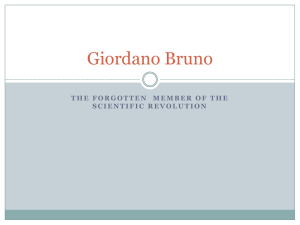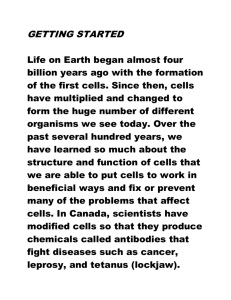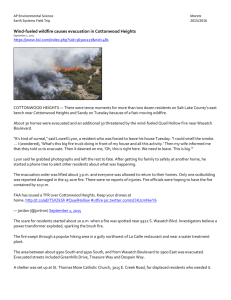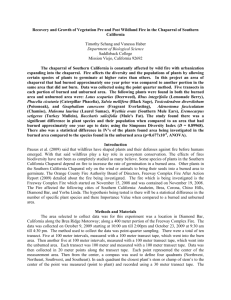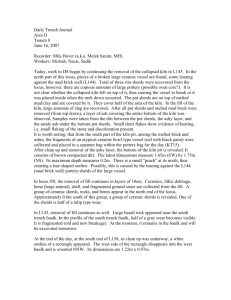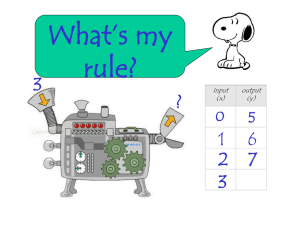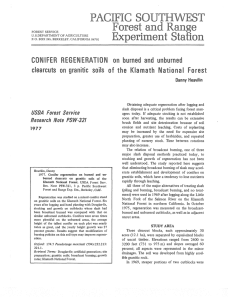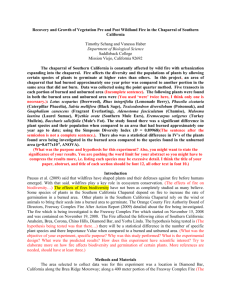Russell Brown Mound 1
advertisement
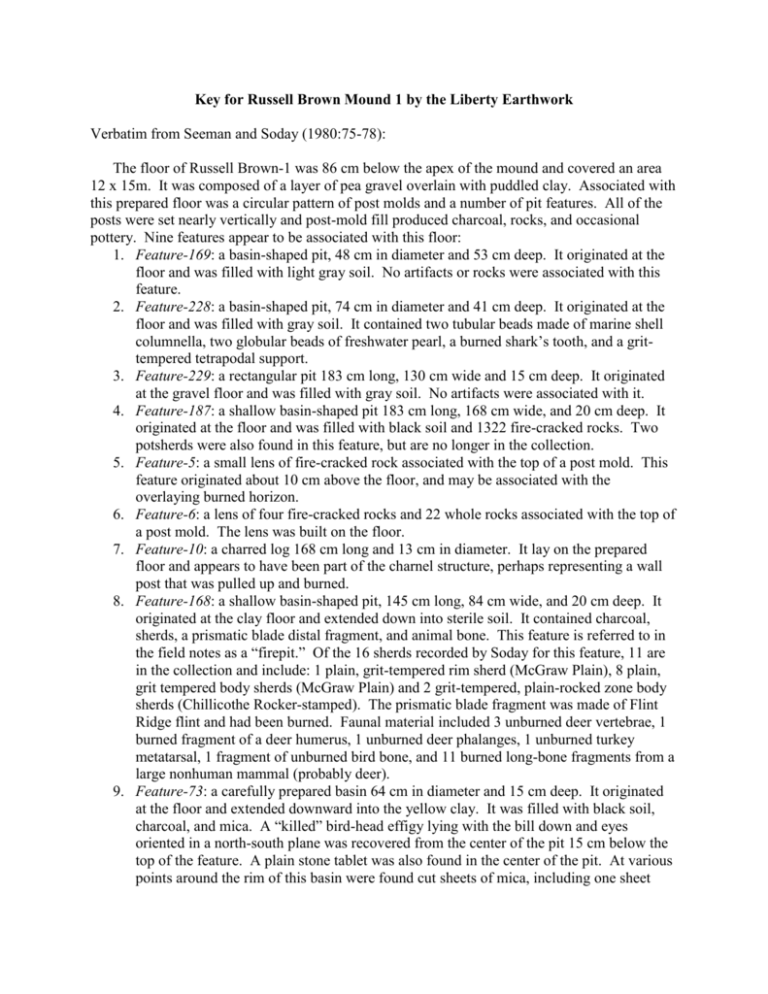
Key for Russell Brown Mound 1 by the Liberty Earthwork Verbatim from Seeman and Soday (1980:75-78): The floor of Russell Brown-1 was 86 cm below the apex of the mound and covered an area 12 x 15m. It was composed of a layer of pea gravel overlain with puddled clay. Associated with this prepared floor was a circular pattern of post molds and a number of pit features. All of the posts were set nearly vertically and post-mold fill produced charcoal, rocks, and occasional pottery. Nine features appear to be associated with this floor: 1. Feature-169: a basin-shaped pit, 48 cm in diameter and 53 cm deep. It originated at the floor and was filled with light gray soil. No artifacts or rocks were associated with this feature. 2. Feature-228: a basin-shaped pit, 74 cm in diameter and 41 cm deep. It originated at the floor and was filled with gray soil. It contained two tubular beads made of marine shell columnella, two globular beads of freshwater pearl, a burned shark’s tooth, and a grittempered tetrapodal support. 3. Feature-229: a rectangular pit 183 cm long, 130 cm wide and 15 cm deep. It originated at the gravel floor and was filled with gray soil. No artifacts were associated with it. 4. Feature-187: a shallow basin-shaped pit 183 cm long, 168 cm wide, and 20 cm deep. It originated at the floor and was filled with black soil and 1322 fire-cracked rocks. Two potsherds were also found in this feature, but are no longer in the collection. 5. Feature-5: a small lens of fire-cracked rock associated with the top of a post mold. This feature originated about 10 cm above the floor, and may be associated with the overlaying burned horizon. 6. Feature-6: a lens of four fire-cracked rocks and 22 whole rocks associated with the top of a post mold. The lens was built on the floor. 7. Feature-10: a charred log 168 cm long and 13 cm in diameter. It lay on the prepared floor and appears to have been part of the charnel structure, perhaps representing a wall post that was pulled up and burned. 8. Feature-168: a shallow basin-shaped pit, 145 cm long, 84 cm wide, and 20 cm deep. It originated at the clay floor and extended down into sterile soil. It contained charcoal, sherds, a prismatic blade distal fragment, and animal bone. This feature is referred to in the field notes as a “firepit.” Of the 16 sherds recorded by Soday for this feature, 11 are in the collection and include: 1 plain, grit-tempered rim sherd (McGraw Plain), 8 plain, grit tempered body sherds (McGraw Plain) and 2 grit-tempered, plain-rocked zone body sherds (Chillicothe Rocker-stamped). The prismatic blade fragment was made of Flint Ridge flint and had been burned. Faunal material included 3 unburned deer vertebrae, 1 burned fragment of a deer humerus, 1 unburned deer phalanges, 1 unburned turkey metatarsal, 1 fragment of unburned bird bone, and 11 burned long-bone fragments from a large nonhuman mammal (probably deer). 9. Feature-73: a carefully prepared basin 64 cm in diameter and 15 cm deep. It originated at the floor and extended downward into the yellow clay. It was filled with black soil, charcoal, and mica. A “killed” bird-head effigy lying with the bill down and eyes oriented in a north-south plane was recovered from the center of the pit 15 cm below the top of the feature. A plain stone tablet was also found in the center of the pit. At various points around the rim of this basin were found cut sheets of mica, including one sheet near the northeastern rim, one sheet on the northwestern rim, and a group of at least five sheets on the southwest rim. Immediately above the prepared clay floor was a horizon referred to in the field notes as the “burned zone,” the “fired layer,” or the “cremation area.” This appears to have been a zone of burned soil, which, as a result of differential burning, evidenced considerable local variability in color and texture. Some areas were brick-red and hard as a result of intense burning, while others were black or brown with various concentrations of charcoal and ash. This zone was of variable thickness, ranging from about 3 cm near the periphery to 43 cm near the center of the mound. Quantities of debris were scattered throughout this horizon, and 6 features and at least 10 post molds were clearly associated with it. The post molds are part of the same pattern and size as those apparently terminating in the underlying floor (mean diameter = 20.0 cm, s = 5.6; mean length = 50.4 cm, s = 16.2; N = 51). It should be noted that the specific provenience information was recorded for only 178 of the 255 sherds and for only 11 of the 26 prismatic blades recovered from this zone; thus, any statement regarding the spatial distribution of cultural material across this horizon may be biased. The poorly provenienced artifacts were merely sorted on the basis of general morphology and included in simple frequency comparisons of the three mounds. Other artifacts found in this horizon include two biglobular “bird” vessels, a carved biotite ball, a “killed” incised tablet and two copper buttons. Also charred fragments of mud-dauber’s nests were recovered from this zone. The features associated with the burned zone were: 10. Feature-23: a circular pit 43 cm in diameter and 25 cm deep. It originated at the top of the burned horizon, was filled with ashes and charcoal, and was lined with, and surrounded by, a dense red earth. The field notes indicate that it was “burned in situ.” 11. Feature-167: a circular pit 56 cm in diameter and 15 cm deep. It originated at the top of the burned horizon and was filled with 36 rocks, 29 of which were fire-cracked. 12. Feature-210: a circular area 51 cm long by 51 cm wide and of indeterminate depth. It is primarily composed of a dense mass of charcoal which appears to be the remains of several charred logs 10 to 15 cm in diameter. Within this mass were a number of sherds, a prismatic blade, and faunal material. All seven sherds listed in the field notes and associated with this feature are still in the collection, and include: one grit-tempered, cordmarked body sherd (McGraw Cordmarked) and six grit-tempered, plain body sherds (McGraw Plain). The prismatic blade was made of Flint Ridge flint and was not burned. Faunal material included: 2 burned deer astragali, 1 burned fragment of deer femur, 1 burned fragment of deer long bone, 5 unburned fragments of bird bone, 1 unburned illium of a small rodent, 26 burned, nonhuman mammal bone fragments, and 12 unburned, nonhuman mammal bone fragments. 13. Feature-176: a shallow basin 66 cm in diameter and 15 cm deep. It originated at the very top of the black zone and was “on a densely burned ash bed.” The sides of the pit were burned to a deep red, and it was filled with black ashes and burned bone. Faunal elements include: 1 unburned deer vertebra, 1 burned fragment of deer antler, 6 burned fragments of bird bone, 2 unburned fragments of bird bone, 47 fragments of burned mammal bone, 18 unburned fragments of mammal bone, and 2 mussel hinges. 14. Feature-198: a basin-shaped pit, 33 cm in diameter and 15 cm deep that originated at the top of the burned layer. It was filled with gray soil and contained 3 sherds, several small flakes of mica, and burned bone. All 3 sherds are grit-tempered, incised (Mound City Incised), and constitute sherds from the same vessel. Other sherds from this same vessel were found elsewhere in the mound. None of the several hundred small burned bone fragments were identifiable (C.O. Lovejoy, personal communication). 15. Feature-97: a circular deposit 30 cm in diameter of trimmed mica sheets.
